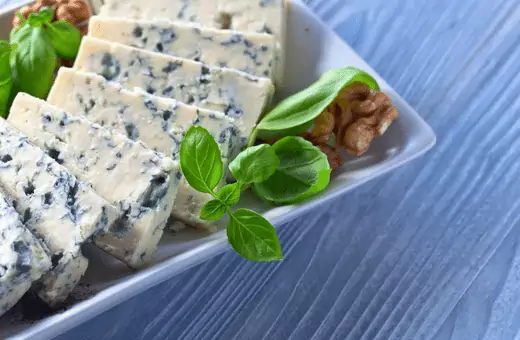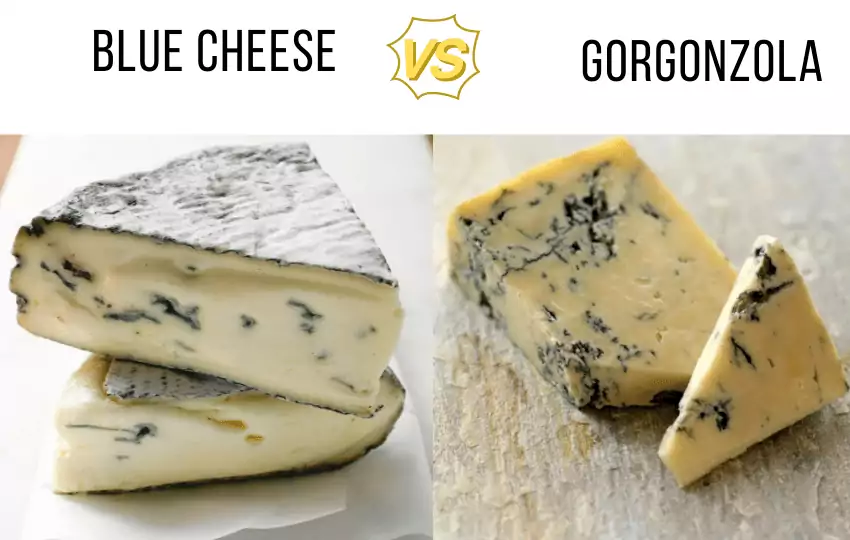If you’re a fan of blue cheese, chances are you’ve tasted both blue cheese and Gorgonzola.
Most people debating over blue cheese vs Gorgonzola because both are in the same cheese category. But do you know they both have some differences?
Read on to learn more about these two kinds of cheese and find out which one is best for you.
What is the difference between blue cheese and Gorgonzola?
What is Blue cheese?
Blue cheese is a cheese that has been treated with mold to create its blue veining. The mold penicillium gives the cheese its blue color and distinct flavor. Cow, goat, or sheep’s milk can be used to make blue cheese. It is generally aged for two to three months, but some types of blue cheese can last up to a year.
There are numerous types of blue cheese, each with its own unique flavor. Some of the most popular types include Gorgonzola, Roquefort, and Stilton. Blue cheese is often used in salads, as a topping on burgers or pizza, or even just enjoyed on its own.
What is gorgonzola cheese?
Gorgonzola cheese is a type of Italian blue cheese that is made from cow’s milk. It has a salty, pungent flavor and a crumbly texture.
Gorgonzola cheese can be used in many different dishes, such as salads, pasta dishes, and pizza. It’s also a popular topping for crackers or bread.
Why Gorgonzola is so good?
Gorgonzola has a unique and salty flavor that is loved by many. Some say it is an accepted taste, but you will be hooked once you acquire a taste for it! This cheese is excellent for those who enjoy bold and flavorful cheeses.
The sharpness of the cheese can liven up a boring salad or pasta dish. If you’re looking for something different, put on your pizza, risottos, pizza topping, omelets, and polenta.
Blue cheese VS Gorgonzola: What’s the other difference?
The main difference between blue cheese and Gorgonzola is that.
1. Blue cheese is a generic term for cheeses with blue veins running through them. At the same time, Gorgonzola is a specific type of blue cheese from Italy.
2. There are many different types of blue cheese, all with their own distinct flavor and texture. Gorgonzola has a sharp, pungent flavor and a crumbly texture.
3. Gorgonzola is made from cow’s milk and has a fat content of around 45%. Blue cheese is also high in fat, typically around 30-35%. The higher fat content gives it a richer, creamier taste. Blue cheese is a fantastic source of protein and calcium and is also relatively low in calories.
4. A one-ounce (28 gram) serving of blue cheese contains around 100 calories. Gorgonzola is a bit higher in calories, with a one-ounce (28 gram) serving containing around 120 calories.
5. Blue cheese is also a good source of phosphorus and vitamin B12. Gorgonzola is slightly higher in sodium than blue cheese, with a one-ounce (28 gram) serving containing around 180 mg of sodium. Blue cheese is also a good source of zinc and copper.
6. Aging time: Gorgonzola is aged for a shorter time than blue cheese, which contributes to its creamier texture.
7. Milk Source: Gorgonzola is made with cows’ milk, while blue cheese can be made with cows’ milk, goat’s milk, or sheep’s milk.
8. When it comes to appearance, Gorgonzola cheese can range in color from white to pale yellow, while blue cheese is typically more of a deep blue or greenish color.
When to use blue cheese and Gorgonzola, differentiating the two kinds of cheese?
If you want a strong, bold flavor in your dish, go with blue cheese. If you prefer a more subtle flavor or need a cheese that will melt easily, go with Gorgonzola. And, of course, there are always oddities to the rule.
Gorgonzola VS Blue cheese: Storage
-To store blue cheese, wrap it in wax paper or place it in a covered container in the refrigerator.
-To store Gorgonzola, wrap the cheese in parchment paper and place it in a plastic bag before storing it in the refrigerator.
Best way to Use Blue cheese & Gorgonzola
Blue cheese and Gorgonzola can be used in various ways in the kitchen.
Add them to salads or other dishes as a topping. This will give your dish an extra zing of flavor.
· Use these cheeses to cook with them. You can add them to pasta plates or use them instead in regular cheese recipes. blue cheese and Gorgonzola both have a strong flavor,
so it is vital to use them sparingly. If you are looking for a more mild flavor, you may want to try using another type of cheese.
Which is stronger blue cheese or Gorgonzola?
Blue cheese is stronger than Gorgonzola. Blue cheese has a stronger flavor because it is made with mold. The mold in blue cheese gives it a strong, sharp taste.
Gorgonzola has a milder flavor because it is made with bacteria. Bacteria do not have the same strong flavor as mold.
Which is healthier blue cheese or Gorgonzola?
When it comes to blue cheese, two types stand out – blue cheese and Gorgonzola. So, which is healthier? To discover out, let’s look at the nutrition facts of each.
Blue Cheese:
– Calories: 100
– Fat: 7 grams
– Saturated Fat: 4.5 grams
– Cholesterol: 20 milligrams
– Sodium: 330 milligrams
– Carbohydrates: 0 grams
– Protein: 6 grams
Gorgonzola:
– Calories: 100
– Fat: 7 grams
– Saturated Fat: 4.5 grams
– Cholesterol: 20 milligrams
– Sodium: 330 milligrams
– Carbohydrates: 1 gram
– Protein: 6 grams
As you can see, both blue cheese and Gorgonzola have very similar nutritional values. In terms of calories and fat, they are equal.
However, Gorgonzola does have one more gram of carbohydrates. So, blue cheese would be the better choice if you are trying to watch your carb intake.
Similarites of Gorgonzola and blue cheese
There are several similarities between Gorgonzola and blue cheese, the most notable being that they are both types of mold-ripened cheese.
Gorgonzola and blue cheese are both types of blue cheese. They have a similar taste and texture. Both kinds of cheese substituting alternatively.

Both cheeses can be used in various dishes, from salads to pasta sauces. Gorgonzola cheese is blue cheese, but all blue cheese is not Gorgonzola.
Bottom line: Gorgonzola VS Blue Cheese
As it depends on personal preferences. Some people might prefer Gorgonzola’s sharp, tangy flavor, while others might find blue cheese to be more mellow and creamy.
Finally, it is up to the person to decide which cheese they prefer.
FAQs
Q1. Is Gorgonzola made with maggots?
No. Maggots are good for fishing not for making cheese.
q2. What is the taste of Gorgonzola?
Italian Gorgonzola has sharp, pungent flavor.
Some say it tastes similar to other blue cheeses, such as Roquefort or Stilton, while others find its flavor more unique.
It can be used in different dishes, from salads to pasta sauces, and is also often eaten on its own as a snack.
Q3. Is Gorgonzola as strong as blue cheese?
Gorgonzola is not as strong as some other blue cheeses, but it is still quite flavorful. It can be a fantastic addition to many dishes.
Q4. What is the strongest blue cheese?
The strongest blue cheese is Roquefort. It has a rating of 8 out of 10 on the pungency scale.
The next strongest blue cheese is Stilton, followed by Gorgonzola. These cheeses have a pungency rating of 7 out of 10.
Chevre, a fresh goat cheese, is not as strong as the other blue cheeses but still has a distinctively tangy flavor. It has a pungency rating of 5 out of 10.
q5. What is the creamiest blue cheese?
The creamiest blue cheese is Roquefort, followed by Gorgonzola and Chevre.
Roquefort is made from sheep’s milk, while Gorgonzola is made from cow’s milk. Chevre is made from goat’s milk.
Roquefort is a robust and pungent cheese with a salty, crumbly texture and a distinctively sharp flavor.
Gorgonzola is a milder blue cheese than Roquefort, with a creamier texture and a sweet, nutty flavor.
Chevre is the mildest of the three kinds of cheese, with a tangy flavor and a soft, creamy texture.
All three kinds of cheese are high in fat and protein and low in carbohydrates.
Q6. Is Gorgonzola milder than blue cheese?
Gorgonzola is typically considered to be milder than blue cheese. This is because Gorgonzola is made with skimmed or semi-skimmed milk, while blue cheese is made with whole milk.
Gorgonzola also has a softer texture than blue cheese, and its flavor is less pungent and tangy.

